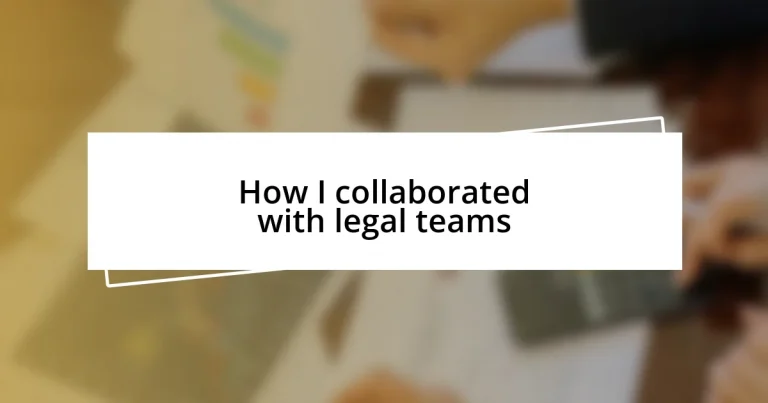Key takeaways:
- Establishing trust and open communication with legal teams enhances collaboration, leading to innovative solutions and a more productive environment.
- Implementing clear roles, responsibilities, and collaborative tools streamlines processes and improves efficiency, reducing misunderstandings and tensions.
- Continuous feedback and celebrating team achievements foster a sense of belonging and drive for improvement, enhancing overall morale and collaboration effectiveness.
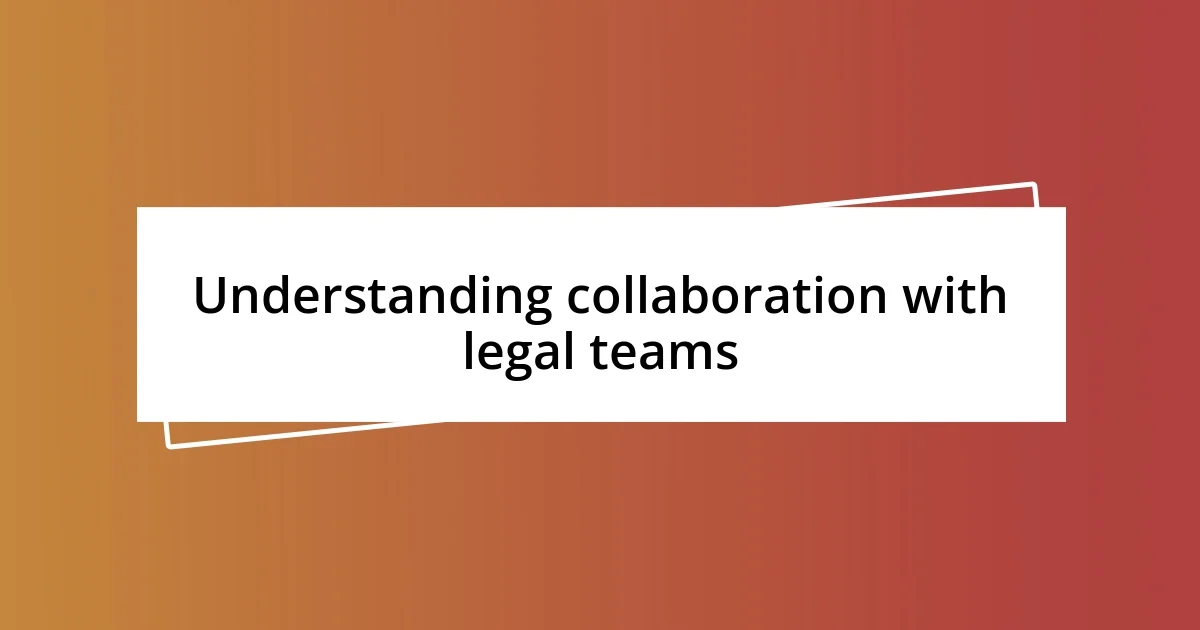
Understanding collaboration with legal teams
Collaboration with legal teams is a multifaceted endeavor. I remember a time when we needed urgent legal input on a project nearing its deadline. The tension in the room was palpable, but I quickly learned how vital open communication is; the moment I reached out with a straightforward question, the legal team sprang into action, providing clarity and direction.
Through my experiences, I’ve realized that establishing trust is essential in these collaborations. When I approached the legal team with transparency about our project goals, it fostered a sense of partnership rather than just a transactional relationship. Have you ever considered how this kind of trust can enhance collaboration? It’s truly transformative and can lead to more innovative solutions.
Moreover, I often find that understanding each other’s language is crucial. Legal jargon can be daunting, especially for those outside the legal realm. I started inviting legal counsel to team meetings to share insights in a more digestible way, and the atmosphere shifted. It became less about fear of legal ramifications and more about a shared goal, creating a more productive and engaging working environment.

Establishing clear communication channels
Establishing clear communication channels with legal teams is foundational for effective collaboration. I recall an instance where a project hit a snag because we were unclear about compliance requirements. By creating a shared digital platform for queries and updates, we significantly reduced misunderstandings. This tool allowed everyone involved to voice concerns openly, making it feel less like a legal obstacle course and more like a collaborative effort towards a shared goal.
- Use of collaborative tools: Implement platforms like Slack or Microsoft Teams to create dedicated channels for legal discussions.
- Regular check-ins: Schedule brief, routine meetings to discuss ongoing projects and legal implications, ensuring everyone stays informed.
- Non-verbal cues: Encourage open dialogue where team members feel empowered to ask questions, fostering a safe space for seeking clarification.
- Visual aids: Utilize flowcharts or infographics to simplify complex legal concepts for the team.
- Feedback loops: Establish mechanisms for continuous feedback on communication effectiveness, allowing real-time adjustments for improvement.
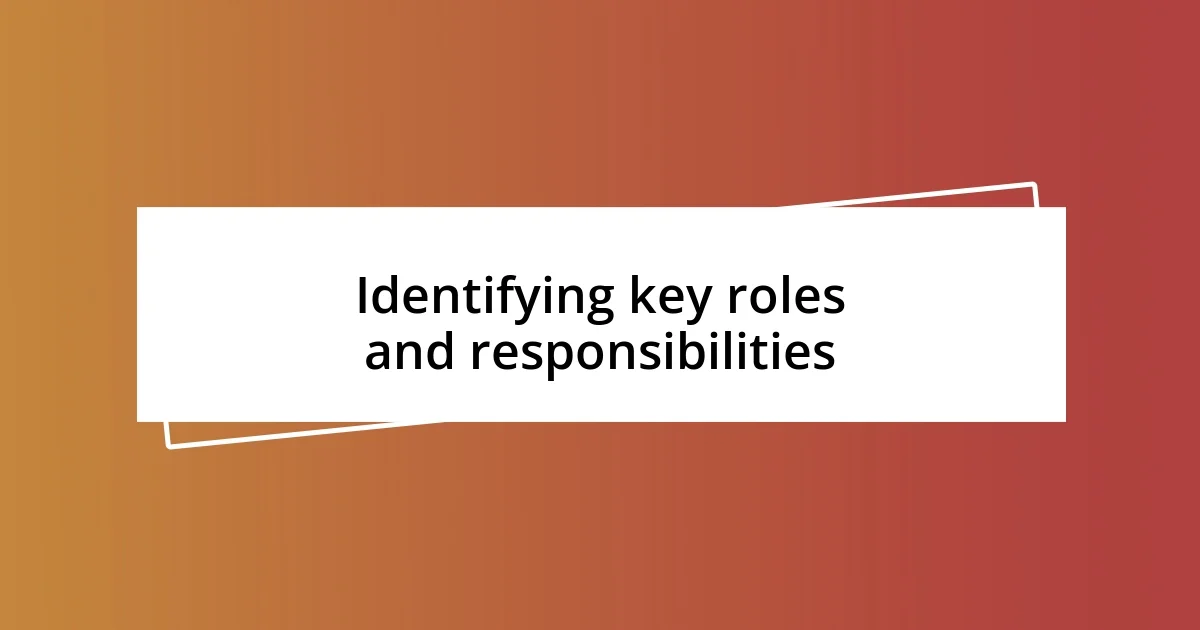
Identifying key roles and responsibilities
Identifying key roles and responsibilities is crucial when collaborating with legal teams. From my experience, clearly defining who does what transforms potential chaos into organized efficiency. For instance, I found that designating a project manager as the main point of contact with the legal team ensured that critical information flowed smoothly. This step helped alleviate misunderstandings and streamlined decision-making. Have you noticed how role clarity can diminish tension in high-pressure scenarios? I sure have!
In one of my previous projects, I realized the importance of including regulatory affairs specialists early on. Before, we would consult them late in the process, often resulting in significant changes. By integrating them from the beginning, we not only saved time but also fostered a sense of collaboration where everyone’s expertise was appreciated. This proactive approach not only built a stronger rapport but also ensured that compliance wasn’t an afterthought.
Here’s a comparison of key roles based on my observations:
| Role | Responsibilities |
|---|---|
| Project Manager | Acts as the main liaison between teams, coordinates communication. |
| Legal Counsel | Provides legal insights, reviews documents, and offers guidance. |
| Regulatory Affairs Specialist | Ensures compliance with laws and regulations, reviews processes. |
| Compliance Officer | Identifies risks, implements compliance measures, and monitors adherence. |

Developing collaborative workflows and processes
Developing collaborative workflows and processes requires intentional design and accountability. One time, I implemented a project management tool that allowed everyone to track their tasks and deadlines. Not only did this transparency foster a sense of ownership, but it also made us collectively share the responsibility for project outcomes. Don’t you think seeing your teammates working towards the same goals creates a unique camaraderie?
Regularly scheduled check-ins can be a game-changer. In my experience, setting aside ten minutes each week for informal touchpoints transformed our group dynamics. Instead of waiting for issues to bubble up, we were able to address concerns before they escalated. I often found it reassuring to witness my team members expressing their challenges, knowing that we were all in it together.
Additionally, visual tools can simplify complex processes immensely. When I introduced flowcharts during team discussions, it was like unlocking a new dimension of understanding. Suddenly, legal jargon transformed into visual stories that everyone could digest. Have you ever noticed how a well-crafted visual can make a daunting task feel manageable? It’s a small shift that can lead to significant enhancements in teamwork and collaboration.
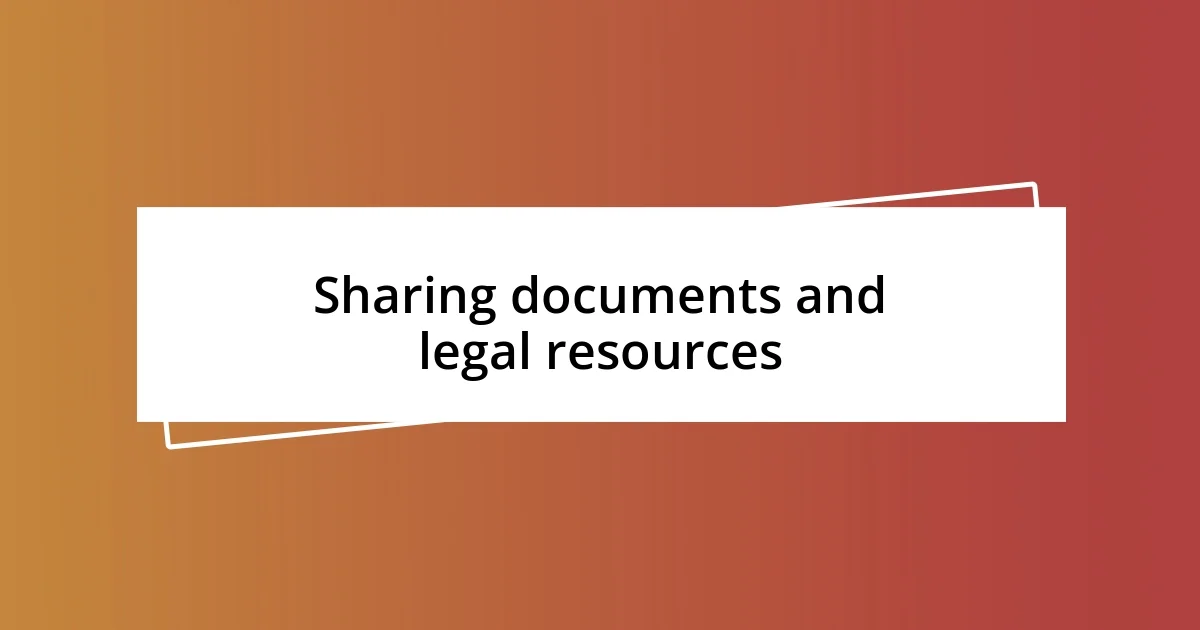
Sharing documents and legal resources
Sharing documents and legal resources is an essential part of collaborating effectively with legal teams. My experience has shown that using a centralized platform for document sharing can save a lot of headaches. For instance, I once worked on a project where we used a cloud-based tool, enabling everyone to access the same files simultaneously. It not only eliminated the confusion of version control but also made it so much easier to retrieve necessary documents when needed. Have you ever felt the frustration of a mismanaged document trail?
Another significant insight from my journey involves the importance of clear labeling and organization of legal resources. In a previous collaboration, I noticed that having a standardized naming convention for files helped my team quickly locate the information we needed. It might seem trivial, but think about how much time could be wasted sifting through poorly labeled files. Adopting this practice improved our efficiency and reduced the chances of errors creeping into our work. Isn’t it impressive how a simple change can have such a profound impact on teamwork?
Additionally, fostering an environment where legal considerations are openly discussed is vital. I remember a project where we held regular sessions dedicated to dissecting legal documents and their implications. These discussions not only demystified complex legal jargon but also empowered the team to contribute their insights. It was rewarding to see how everyone felt more engaged and informed, transforming our approach to legal matters from daunting to collaborative. Have you ever experienced that moment of clarity when everyone is on the same page? It’s exhilarating!

Overcoming common challenges in collaboration
One of the biggest challenges I faced in collaboration was navigating differing priorities among team members. I recall a particularly intense project where everyone’s schedules felt like a game of chess. To tackle this, I suggested we create a shared priority matrix. This simple document helped us visualize our collective goals and align our efforts. Have you ever felt the relief of seeing how everyone’s input fits into a bigger picture? It bridged gaps and transformed potential conflicts into collaborative discussions, making everyone feel valued and included.
Miscommunication can quickly derail a project. I vividly remember a time when a misunderstanding about deadlines led to unnecessary stress and frantic last-minute work. I learned that establishing clear communication protocols—like using concise emails and a shared calendar—was essential. It sounds straightforward, but this little shift drastically improved not only our efficiency but also our morale. Can you imagine the team spirit when everyone is on the same wavelength?
Finally, integrating feedback from all team members proved critical to overcoming resistance to change. During one of our legal reviews, I encouraged open feedback sessions where everyone could voice concerns or suggestions. I was surprised by how many innovative ideas emerged when people felt safe to share. This wasn’t just about gathering input; it was about creating an atmosphere where everyone felt they had a stake in the process. Have you ever noticed how energizing it is when the whole team contributes to problem-solving? The collaborative energy became palpable, turning challenges into opportunities for growth and connection.
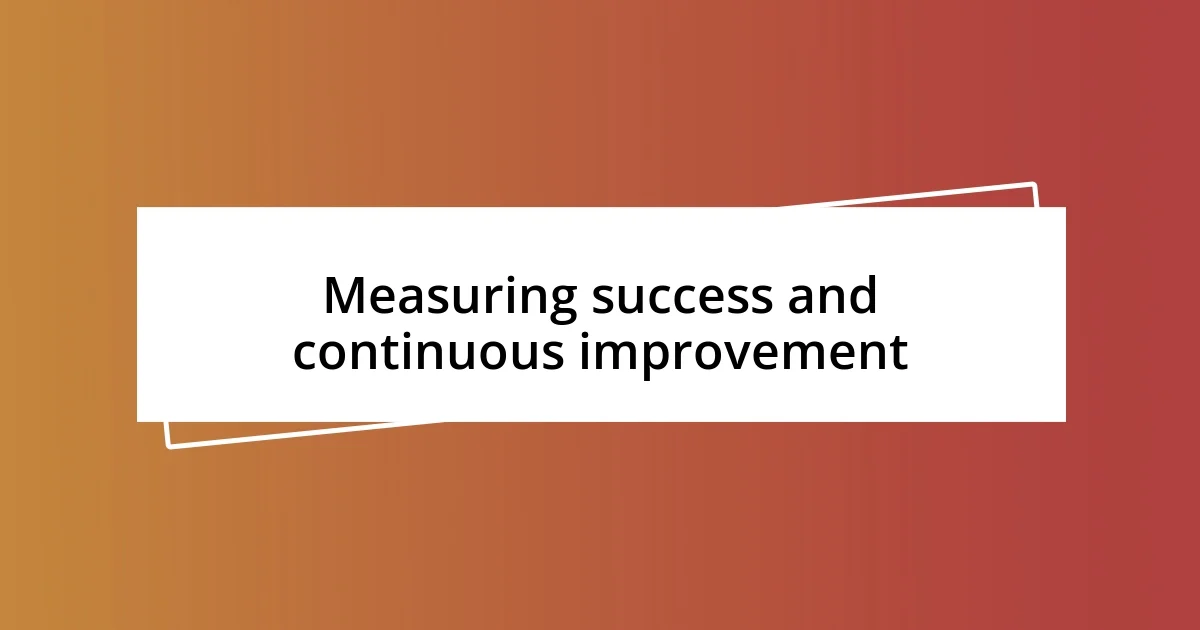
Measuring success and continuous improvement
Measuring success in collaboration is about more than assessing outcomes; it’s about reflecting on the processes that got us there. I remember tracking the time spent on legal reviews for a particular project. By identifying bottlenecks in the review stages, we made adjustments that cut down on delays. Have you ever noted how a small change can unlock new levels of productivity? It’s fascinating how simply being aware of where time is lost fuels our drive for continuous improvement.
When I assess how effectively we’ve collaborated, I often gauge team satisfaction as well. I once distributed a survey after finishing a major project, asking teammates how they felt about our communication and support. The feedback revealed insights I hadn’t considered; for example, one team member suggested more frequent check-ins. Implementing that idea not only improved our workflows, but it also fostered a sense of belonging. Have you ever felt the power of collective input leading to change? It’s truly transformative.
In striving for constant improvement, we also began celebrating our wins, big and small. I initiated monthly retrospectives to review completed projects, which included recognizing individual contributions as well as team successes. I could see how this practice lifted spirits; the enthusiasm was contagious! Don’t you think acknowledging achievements can be a game-changer for team morale? It encourages everyone to stay engaged and motivated, reinforcing our commitment to evolving and growing together.












